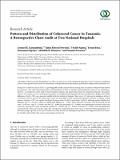| dc.contributor.author | Katalambula, Leonard | |
| dc.contributor.author | Ntwenya, Julius | |
| dc.contributor.author | Ngoma, Twalib | |
| dc.contributor.author | Buza, Joram | |
| dc.contributor.author | Mpolya, Emmanuel | |
| dc.contributor.author | Mtumwa, Abdallah | |
| dc.contributor.author | Petrucka, Pammla | |
| dc.date.accessioned | 2019-10-07T10:01:13Z | |
| dc.date.available | 2019-10-07T10:01:13Z | |
| dc.date.issued | 2016-08-09 | |
| dc.identifier.uri | http://dx.doi.org/10.1155/2016/3769829 | |
| dc.identifier.uri | http://dspace.nm-aist.ac.tz/handle/123456789/454 | |
| dc.description | Research Article published by Hindawi Publishing Corporation | en_US |
| dc.description.abstract | Background. Colorectal cancer (CRC) is a growing public health concern with increasing rates in countries with previously known
low incidence. This study determined pattern and distribution of CRC in Tanzania and identified hot spots in case distribution.
Methods. A retrospective chart audit reviewed hospital registers and patient files from two national institutions. Descriptive
statistics, Chi square (𝜒2) tests, and regression analyses were employed and augmented by data visualization to display risk variable
differences. Results. CRC cases increased sixfold in the last decade in Tanzania. There was a 1.5% decrease in incidences levels of
rectal cancer and 2% increase for colon cancer every year from 2005 to 2015. Nearly half of patients listed Dar es Salaam as their
primary residence. CRC was equally distributed between males (50.06%) and females (49.94%), although gender likelihood of
diagnosis type (i.e., rectal or colon) was significantly different (𝑃 = 0.027). More than 60% of patients were between 40 and 69
years. Conclusions. Age (𝑃 = 0.0183) and time (𝑃 = 0.004) but not gender (𝑃 = 0.0864) were significantly associated with rectal
cancer in a retrospective study in Tanzania. Gender (𝑃 = 0.0405), age (𝑃 = 0.0015), and time (𝑃 = 0.0075) were all significantly
associated with colon cancer in this study. This retrospective study found that colon cancer is more prevalent among males at a
relatively younger age than rectal cancer. Further, our study showed that althoughmore patients were diagnosed with rectal cancer,
the trend has shown that colon cancer is increasing at a faster rate. | en_US |
| dc.language.iso | en | en_US |
| dc.publisher | Hindawi Publishing Corporation | en_US |
| dc.subject | Research Subject Categories::NATURAL SCIENCES | en_US |
| dc.title | Pattern and Distribution of Colorectal Cancer in Tanzania: A Retrospective Chart Audit at Two National Hospitals | en_US |
| dc.type | Article | en_US |

